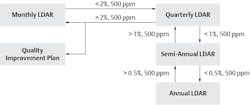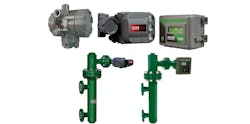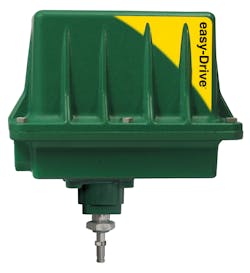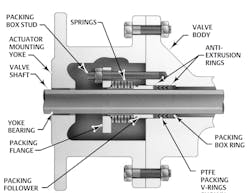Meeting new methane emission standards profitably
Reducing greenhouse gas emissions is a major goal of every energy and chemical company.
Of particular global interest is the reduction of methane because it is 25-30 times more damaging to the environment than carbon dioxide. The United States and Canadian governments are both on this topic, and both have passed environmental rules mandating significant methane emission reductions1,2.
While meeting regulation requirements is clearly a mandate, there is a way to satisfy environmental laws, reduce greenhouse gas emissions and save money in the process.
Upstream emission issues
Many upstream oil and gas sites are located in very remote areas. The control requirements at the well head and early separation sites are relatively simple, but they do require a source of pneumatic or electric energy to operate valves and other instruments. Since compressed air or power are often not available, many companies utilize pressurized natural gas to operate their pneumatic instruments and control valves. This solution works well but creates a problem.
Pneumatic instruments are designed to bleed air constantly, and they vent still more air as they operate the valves. When natural gas is used, it is continuously emitted in considerable quantities. When combined with the fugitive methane emissions associated with valve and pump seal leaks, the total amount of methane released at a remote well site can be significant.
In response to this issue, both the U.S. and Canadian governments have recently passed regulations to reduce greenhouse emissions. In the U.S., the applicable standard is CFR 40 Part 60 Subpart OOOO (Quad O) which states that any equipment installed and/or modified must meet new source performance standards, including a natural gas bleed rate of < 6 SCFH in oil/gas production and processing. There are also revised standards for leak detection and repair (LDAR) inspections. The regulations in Canada target fugitive emission rates as well and dictate a similar < 6 SCFH bleed rate on any pneumatic device using natural gas for operation.
At first blush, a company might view these regulations as burdensome and expensive. However, there is a hidden financial benefit associated with these rules that can help offset costs and even save money in the long term.
Hidden savings
Consider a single pneumatic pressure controller and an associated pneumatic control valve with positioner operating at a remote well site. Since no compressed air or power are available, pressurized natural gas is utilized to operate the equipment. A typical pneumatic pressure controller bleeds up to 54 SCFH of natural gas, while the associated pneumatic control valve with positioner bleeds another 26 SCFH.
Not only are these devices violating the regulations, but this one control loop is wasting 700,800 SCF of fuel gas per year every year it is in service. The price of natural gas varies, but using an average figure of $2.00/GJ, that equates to $1,400 of gas wafting away per loop per year. The cost to the company is even higher if carbon credits are taken into account. If that equipment could be replaced with a low- or zero-bleed option, it would satisfy the new regulations and save considerable money.
Another source of cost reduction is posed by the new LDAR standards. The Quad O standard mandates monthly inspections if greater than 2% of the devices have fugitive emissions above the 500 ppm emissions threshold (Figure 1).
However, as the percentage of failed emissions tests fall, the required inspections drop to quarterly, semi-annually and — eventually — to annual inspections if less than 0.5% of the devices fail the test inspections. A company therefore can reduce LDAR inspection costs twelvefold if it can keep fugitive emissions low.
Low-bleed pneumatic money saving options
One method to satisfy the regulations and eliminate lost gas is replacing the pneumatic components with low-bleed pneumatic components. All of the controllers, pressure pilots and level controllers shown in Figure 2 offer bleed rates below 6 SCFH.
In many cases, upgrading these components will reduce vented methane by a factor of eight to 10. If our hypothetical pneumatic controller was replaced with a low-bleed controller, such as the Fisher C1, the site would save $845 per year in recovered gas, and it would satisfy the new regulations. Note that lower cost retrofit kits are available for some models to convert them to low bleed.
Low-bleed electric/electro-pneumatic money saving options
Another alternative to meet the standards and recover gas is replacing the existing pneumatic components with recently introduced all electric and/or electro-pneumatic low-bleed components. Improvements in solar energy panels and battery storage systems have enabled low-power electro-pneumatic devices to operate in remote areas, which was not previously possible in many cases.
These devices combine a zero-bleed electronic component with low-bleed pneumatics to further reduce methane venting and save fuel gas. All of the transducers, positioners and level controllers shown in Figure 3 offer bleed rates below 6 SCFH, and inexpensive low-bleed retrofit kits are offered for some instruments.
Pneumatics are still required to operate the valves, but the vented gas is further reduced. If our hypothetical pneumatic controller and control valve positioner are replaced with low-bleed options such as these, the site saves $1,240 per year in gas and complies with new regulations.
Zero venting with electric actuators
If sufficient power is available, pneumatic control valve actuators can be replaced with all electric actuators, such as the Fisher easy-Drive electric actuator shown in Figure 4. This type of actuator can be retrofitted to a number of different control valve brands and styles, and it offers a means to achieve zero methane bleed for the entire site.
Reduced LDAR inspections
As mentioned previously, the past performance of the LDAR inspections dictate the future inspection frequency. If the percentage of devices exceeding 500 ppm emissions can be reduced below 0.5%, the time between inspections can be extended from monthly to annually, reducing inspection costs by a factor of 12.
One method to minimize seal leaks is to consider swapping any troublesome packing with spring-loaded packing, such as the ENVIRO-SEAL packing shown in Figure 5.
Live-loaded packing provides constant compression over the life of the packing material. This helps maintain a very low fugitive emission rate, while requiring little if any packing box adjustment. Such consistent performance translates to significant LDAR inspection savings, thus keeping those costs low over the life of the valve.
Evaluate your options
Emerson offers an Energy Responsible Tool, empowering users to compare various existing instruments against recently introduced low-bleed devices regarding emissions. The tool can be customized by entering exact energy costs and natural gas details, so the cost of operations and potential savings can be specifically tailored to each user application. The tool is free and can be accessed at: http://www.fisher.com/energyresponsibletool/
Conclusion
The latest methane reduction regulations need not be an onerous and expensive burden to energy producers. When the cost of recovered gas and/or carbon credits are considered, the replacement equipment can generate a quick ROI, even as it helps the site meet regulatory requirements.
Lura Parrent is an application engineer for Emerson specializing in Fisher control valves and instruments and is responsible for end users in the upstream oil and gas industry. Lura has been in her current role for two years since her graduation in 2018 from the University of Nebraska-Lincoln with a degree in chemical engineering.
Brian Van Vliet is part of an entrepreneurial team at Spartan Controls. He has worked with Spartan for over 15 years providing environmental solutions and improving field efficiencies for industries across western Canada. Brian received his Bachelor of Science in Mechanical Engineering (Co-op with Distinction) from the University of Alberta and lives in Calgary, Alberta.
References
1. A case study in competing methane regulations: Will Canada’s and Alberta’s contrasting regulations achieve equivalent reductions?, Matthew R. Johnson and David R. Tyner: https://www.elementascience.org/article/10.1525/elementa.403/
2. Directive 060: Upstream Petroleum Industry Flaring, Incinerating, and Venting: https://www.aer.ca/regulating-development/rules-and-directives/directives/directive-060







